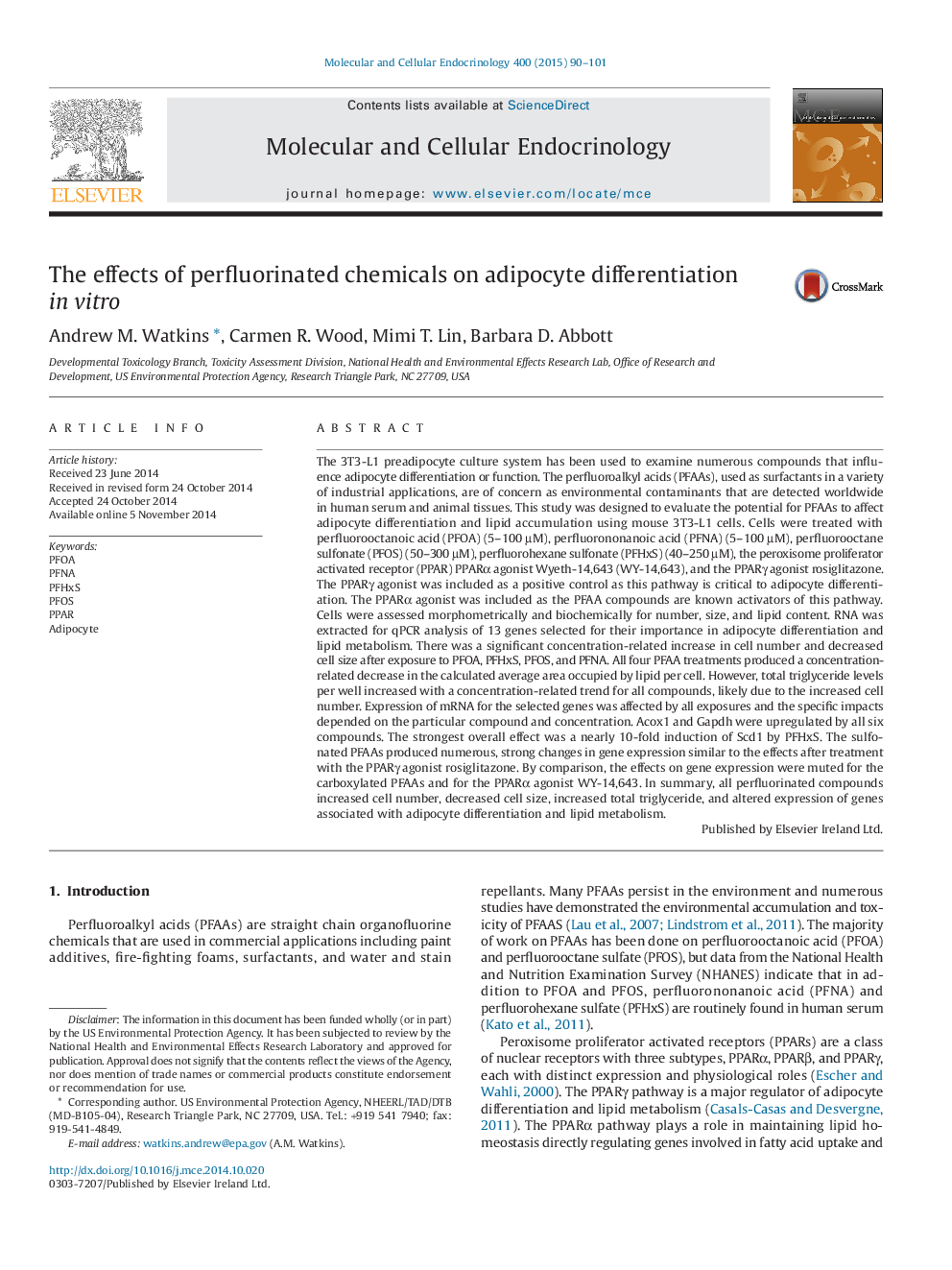| کد مقاله | کد نشریه | سال انتشار | مقاله انگلیسی | نسخه تمام متن |
|---|---|---|---|---|
| 8477131 | 1550878 | 2015 | 12 صفحه PDF | دانلود رایگان |
عنوان انگلیسی مقاله ISI
The effects of perfluorinated chemicals on adipocyte differentiation in vitro
ترجمه فارسی عنوان
اثرات مواد شیمیایی پرفروفی شده بر روی تمایز آدیوسیت در آزمایشگاهی
دانلود مقاله + سفارش ترجمه
دانلود مقاله ISI انگلیسی
رایگان برای ایرانیان
موضوعات مرتبط
علوم زیستی و بیوفناوری
بیوشیمی، ژنتیک و زیست شناسی مولکولی
بیولوژی سلول
چکیده انگلیسی
The 3T3-L1 preadipocyte culture system has been used to examine numerous compounds that influence adipocyte differentiation or function. The perfluoroalkyl acids (PFAAs), used as surfactants in a variety of industrial applications, are of concern as environmental contaminants that are detected worldwide in human serum and animal tissues. This study was designed to evaluate the potential for PFAAs to affect adipocyte differentiation and lipid accumulation using mouse 3T3-L1 cells. Cells were treated with perfluorooctanoic acid (PFOA) (5-100âµM), perfluorononanoic acid (PFNA) (5-100âµM), perfluorooctane sulfonate (PFOS) (50-300âµM), perfluorohexane sulfonate (PFHxS) (40-250âµM), the peroxisome proliferator activated receptor (PPAR) PPARα agonist Wyeth-14,643 (WY-14,643), and the PPARγ agonist rosiglitazone. The PPARγ agonist was included as a positive control as this pathway is critical to adipocyte differentiation. The PPARα agonist was included as the PFAA compounds are known activators of this pathway. Cells were assessed morphometrically and biochemically for number, size, and lipid content. RNA was extracted for qPCR analysis of 13 genes selected for their importance in adipocyte differentiation and lipid metabolism. There was a significant concentration-related increase in cell number and decreased cell size after exposure to PFOA, PFHxS, PFOS, and PFNA. All four PFAA treatments produced a concentration-related decrease in the calculated average area occupied by lipid per cell. However, total triglyceride levels per well increased with a concentration-related trend for all compounds, likely due to the increased cell number. Expression of mRNA for the selected genes was affected by all exposures and the specific impacts depended on the particular compound and concentration. Acox1 and Gapdh were upregulated by all six compounds. The strongest overall effect was a nearly 10-fold induction of Scd1 by PFHxS. The sulfonated PFAAs produced numerous, strong changes in gene expression similar to the effects after treatment with the PPARγ agonist rosiglitazone. By comparison, the effects on gene expression were muted for the carboxylated PFAAs and for the PPARα agonist WY-14,643. In summary, all perfluorinated compounds increased cell number, decreased cell size, increased total triglyceride, and altered expression of genes associated with adipocyte differentiation and lipid metabolism.
ناشر
Database: Elsevier - ScienceDirect (ساینس دایرکت)
Journal: Molecular and Cellular Endocrinology - Volume 400, 15 January 2015, Pages 90-101
Journal: Molecular and Cellular Endocrinology - Volume 400, 15 January 2015, Pages 90-101
نویسندگان
Andrew M. Watkins, Carmen R. Wood, Mimi T. Lin, Barbara D. Abbott,
